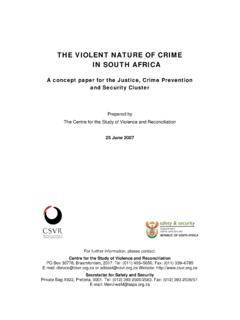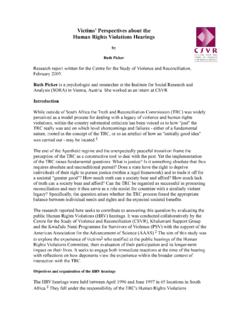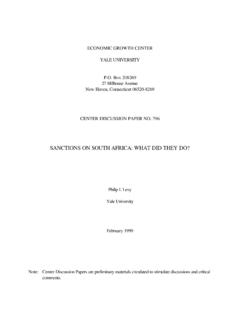Transcription of A Decade of Crime Prevention in South Africa: From a ...
1 A Decade of Crime Prevention in South Africa: From a national strategy to a local challengebyGareth NewhamResearch report written for the Centre for the Study of Violence and Reconciliation, Newham is a former Project Manager in the Criminal Justice Programme at the Centre for the Study of Violence and in May of 1996, the National Crime Prevention Strategy (NCPS) was billed as a holistic national strategy for reducing Crime in South africa . It emerged from the deliberations and research of a multi-disciplinary team of experts from the state and civil society who were tasked with forging a long term strategy to focus the state's attention on addressing the root causes of Crime in the country. This was premised on the understanding that to effectively reduce Crime , an approach that included, but went beyond, the criminal justice system was required.
2 Drawing on international experience the NCPS propagated a strategy that advocated a 'developmental' approach to the Prevention of Crime . This required that Crime be seen as a broader 'social' challenge rather than purely a security one. Consequently, ' Crime Prevention ' in its true sense meant addressing the socio-economic and environmental factors that gave rise to Crime rather than only enforcing the law after it had occurred. However, by the year 2000 the overall vision of the NCPS had dissipated as the state responded to the pressure from a Crime embattled populace by declaring 'war on Crime '. This resulted in governments' primary focus and resources being directed to the institutions of the criminal justice system and the term ' Crime Prevention ; has become synonymous with objective of this paper is to refocus attention on the original vision and meaning of the term ' Crime Prevention ' as set out in the National Crime Prevention Strategy.
3 The first part therefore distinguishes between what has been termed the 'law-enforcement' approach and the ' Crime Prevention ' approach in the international arena. Thereafter, a brief overview of the NCPS and the process of its implementation are presented. This section also reflects on how the original vision of Crime Prevention in the NCPS was taken up in subsequent government policies and how the original vision is still valid in South africa today. The third section demonstrates how Crime Prevention as a tool for enhancing public safety has continued at the local level and some of the current challenges that are being faced and lessons learned to author of this paper works in the Criminal Justice Programme at the Centre for the Study of Violence and Reconciliation (CSVR).
4 The CSVR is a non-profit, public interest organisation that was established in 1989. Committed to deepening democracy and the culture of Human Rights, CSVR undertakes innovative policy research and community based interventions in the fields of transitional justice, reconciliation, criminal justice transformation, youth and gender violence Prevention , victim empowerment and sustainable peace building. CSVR staff were part of the multi-disciplinary team that drafted the NCPS and contributed to later government reviews of the implementation of the and Crime PreventionDuring the 1970s the traditional law-enforcement approach to addressing Crime problems was increasingly under fire for its ineffectiveness. Throughout the developed world Crime rates were increasingly causing general public alarm.
5 The common state response was to increase spending on the institutions of criminal justice. Large numbers of additional police officials were hired and law-enforcement training improved. Initiatives were undertaken to streamline court processes and more prisons were built. However, none of these initiatives managed to stem the growing rise in Crime . As Donziger (1996, p. 198) quite forcefully argues:For the past twenty years, criminal justice practices have been so profoundly ill-conceived that they have been bound to fail. As the failures have accumulated, the justice system has responded by adding more of the same policies. Prison and jail populations in this nation [the United States] have tripled since 1980, and law enforcement expenditures have quadrupled, but polls show that most Americans do not feel safe.
6 Legislatures lengthen sentences and add more mandatory minimum penalties. More police are hired, more prisons built. Still, we do not feel safe. In response, policy-makers continue to expand the same criminal justice apparatus: more enforcement, longer sentences, more prisons. If this 'get tough' strategy worked, the results would be apparent by now. They are the 1970s analysts around the world had already started to more carefully consider the reasons for the ineffectiveness of the law-enforcement approach to combating Crime . It was quickly realised that the law-enforcement approach was reactive and failed to address the root causes of Crime . Criminal justice systems could only react once a Crime had been committed.
7 It was assumed that having a police force would be a deterrent to criminals as they would fear the sanctions they could face once caught. However, comparative research demonstrated that even the best resourced and professional criminal justice systems failed to solve most crimes or apprehend most criminal perpetrators. For instance, Bayley (1994, p. 27) reveals that on average, Canada could only solve 45% of its reported Crime , Britain 35%,Australia 30% and the USA 22%.Further research started to explore the reasons why Crime occurred in the first place. It had been assumed that criminals were morally deviant individuals who committed criminal acts as a result of not being able to adhere to societal norms and values.
8 However, research into this question revealed that most people who engage in various forms of criminal conduct do not necessarily differ in any measurable manner from law abiding individuals (see for instance Travis and Weisberse, 1997 as cited in Palmary, 2002). Rather, when looking at Crime rates and patterns generally, Crime was more clearly linked to a combination of powerful social, economic and demographic forces and dynamics. For instance large-scale, longitudinal research in a number of developed countries have clearly demonstrated that, "youth who are exposed to any of all of the following conditions are more likely to commit delinquent acts than those who are not (Waller and Sansfacon, 2000, p. 5): Relative poverty and inadequate housing; Inconsistent or insufficient parental or guardian guidance; Limited social and cognitive abilities; Exclusion from school; Family violence; Few opportunities for employment and economic exclusion; A culture of , developments in what has been termed 'environmental criminology' have revealed that Crime and victimisation are clearly influenced by 'place based or spatial factors' (Bottoms and Wiles, 2002, p.)
9 621). That environmental factors has a direct influence on patterns of offending has been taken up and popularised by James Q. Wilson and George Kellings (1982) 'broken window' theory which demonstrated that certain signs of disorder (broken windows, housing abandonment, litter and graffiti) will encourage criminality in strong link between socio-economic and environmental and Crime led to a new approach towards understanding and addressing the problem. The core idea behind what was termed to be the ' Crime Prevention ' approach was that through intervening in the particular causal factors that lead to a criminal incident occurring, Crime and all its negative consequences can be prevented. It was obvious that many of the above factors could not be addressed by only the police or other CJS institutions.
10 Other government departments ( education, health, and welfare, city planning, etc), as well organisations in civil society had a critical role to play in Crime reduction. In order to guide the types of programmes that could be used for Crime Prevention , a typology that distinguished between primary, secondary and tertiary approaches to Crime Prevention was initially developed by Brantingham and Faust (1976).Primary Crime Prevention focuses on a range of environmental factors that can lead to Crime occurring. Pease, 2002, p. 954 cites two volumes of separate and successful case studies in which Crime has been reduced (Clark, 1992 and 1997). Examples of such initiatives include simple target hardening ( the use of steering locks to prevent car theft) to environmental design (street lighting and housing design that can reduce Crime by up to 30%) and urban Crime Prevention focuses on groups of people who are at risk of offending or becoming victims of Crime .















